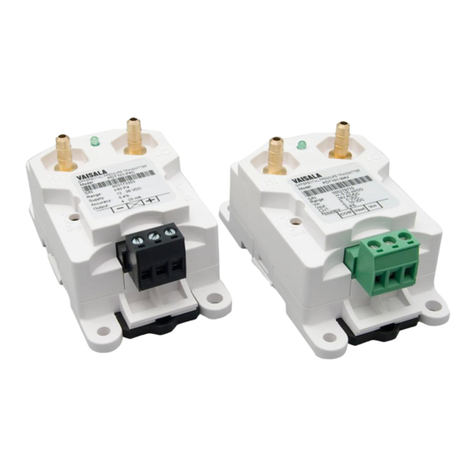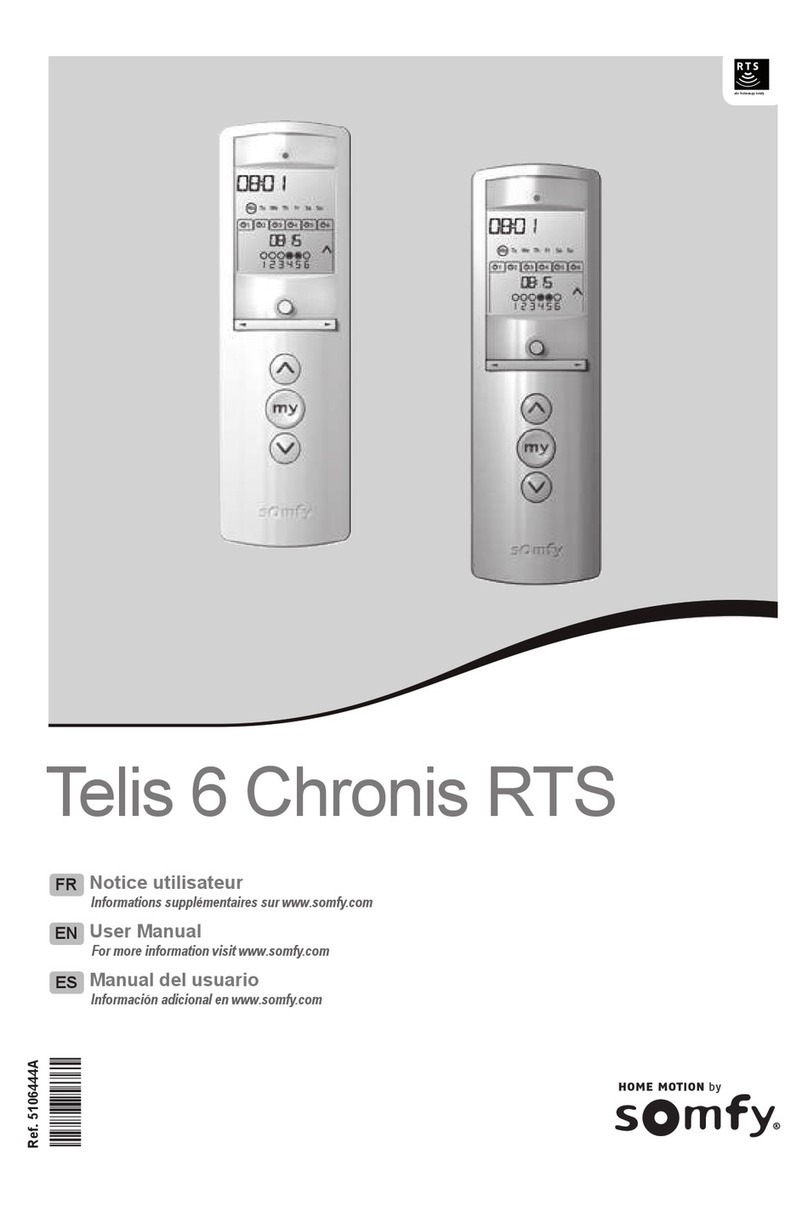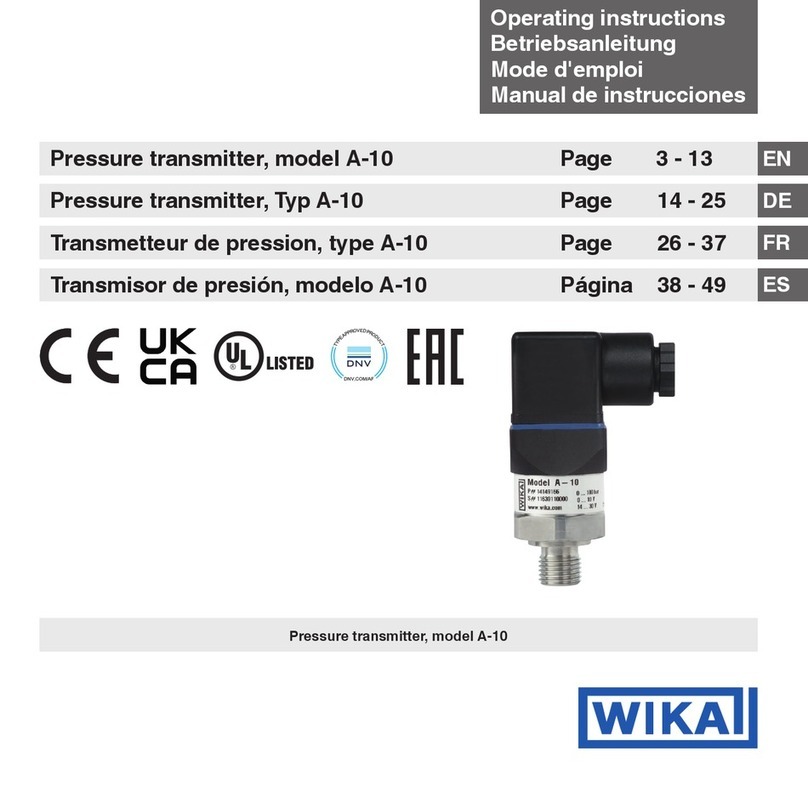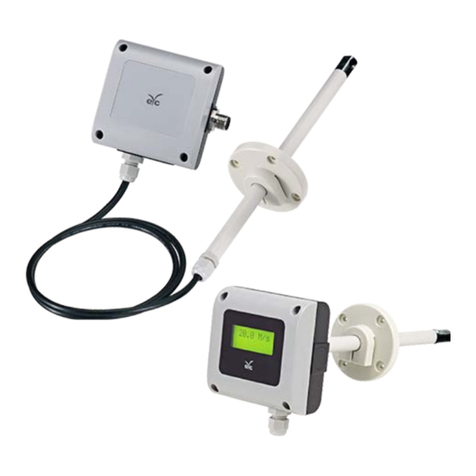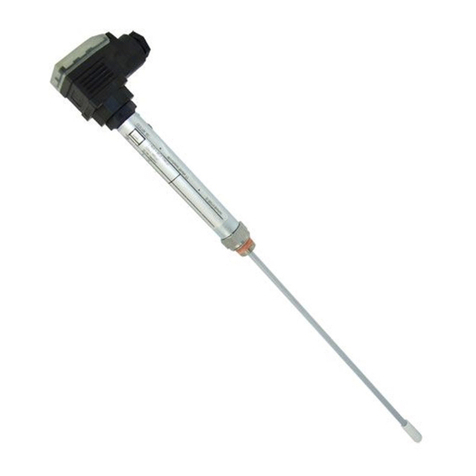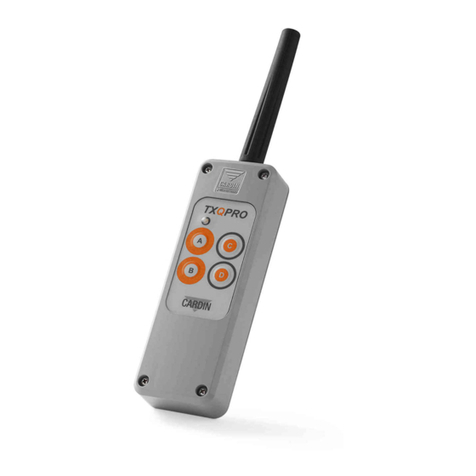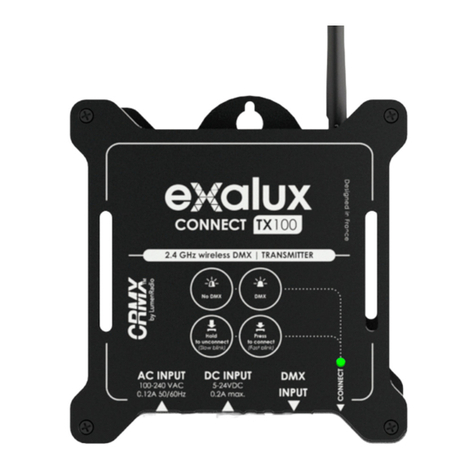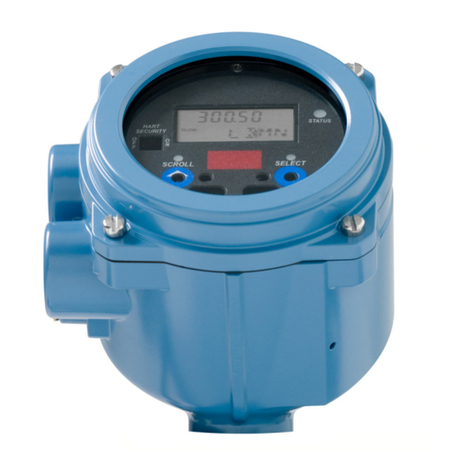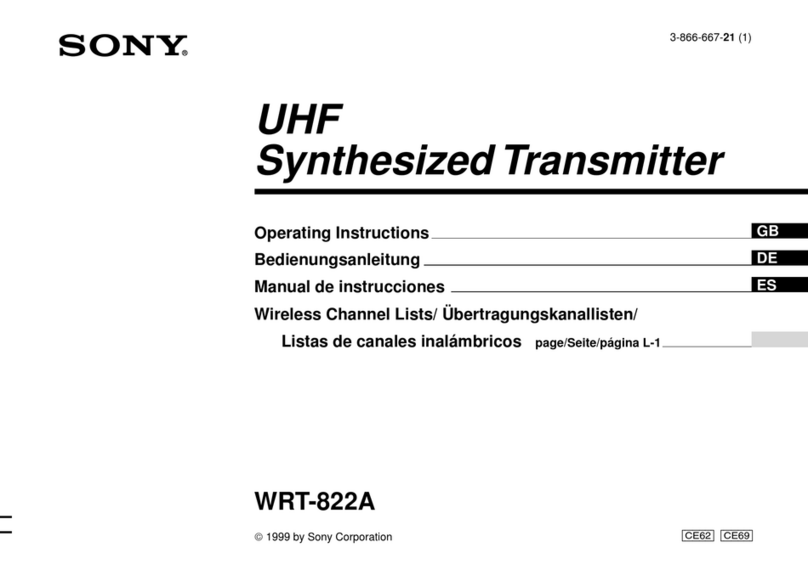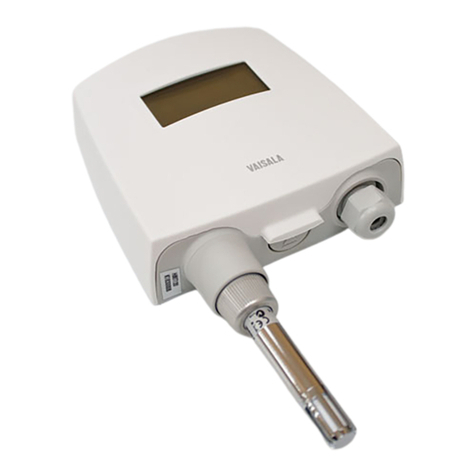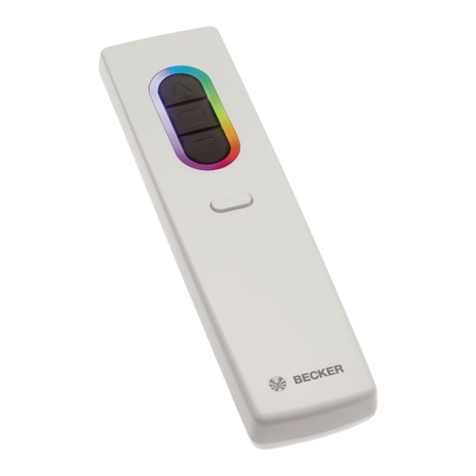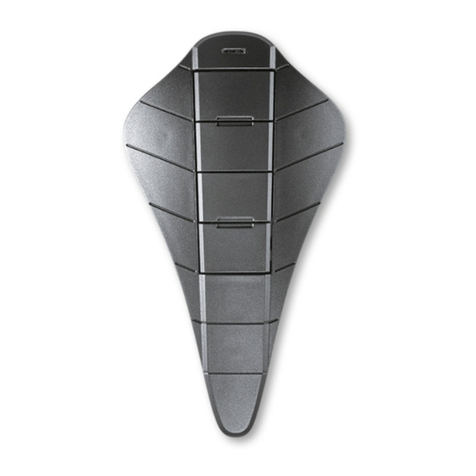Novatech 1732 User manual

Oxygen Transmitter
Model 1732
Operators Manual
February 2015


TABLE OF CONTENTS
1. USING THIS MANUAL ................................................................................................................................. 3
1.1 CAUTIONS.................................................................................................................................................. 3
1.2 WARNING SYMBOLS ................................................................................................................................... 4
2. INTRODUCTION........................................................................................................................................... 5
3. DEVICE SPECIFICATIONS.......................................................................................................................... 7
3.1 HARDWARE SPECIFICATIONS....................................................................................................................... 7
3.2 OPERATIONAL SPECIFICATIONS................................................................................................................... 8
3.2.1 SCALING OF ANALOG OUTPUTS CHANNEL #1 AND CHANNEL #2 ............................................................. 8
3.2.2 LOCAL DISPLAY OF PROCESS VARIABLES.............................................................................................. 8
4. DISPLAY AND KEYPAD .............................................................................................................................. 9
4.1 RUN MODE DISPLAY................................................................................................................................... 9
4.2 OXYGEN DISPLAY..................................................................................................................................... 10
4.3 KEYPAD ................................................................................................................................................... 11
4.3.1 KEYPAD IN RUN MODE ....................................................................................................................... 11
4.3.2 KEYPAD IN THE SETUP MENU ............................................................................................................. 12
4.3.3 INFORMATION SCREEN....................................................................................................................... 13
5. SETUP MENU ............................................................................................................................................. 15
5.1 SETUP MENU FUNCTION SUMMARY........................................................................................................... 15
5.2 SETUP MENU DISPLAY.............................................................................................................................. 15
5.3 SETUP MENU FUNCTIONS ......................................................................................................................... 16
5.3.1 PROBE 1&PROBE 2OFFSET............................................................................................................. 16
5.3.2 LOWER LINE ITEMS ............................................................................................................................ 16
5.3.3 OXYGEN DISPLAY UNITS .................................................................................................................... 17
5.3.4 DAMPING FACTOR.............................................................................................................................. 17
5.3.5 PROCESS ALARMS............................................................................................................................. 17
6. ALARMS ..................................................................................................................................................... 19
6.1 CHECKING AND ACCEPTING AN ALARM ...................................................................................................... 20
6.1.1 CURRENT ALARMS............................................................................................................................. 20
6.1.2 ALARM LOG....................................................................................................................................... 21
6.2 ALARM RELAYS ........................................................................................................................................ 21
6.3 COMMON ALARMS .................................................................................................................................... 22
6.4 SELECTABLE PROCESS ALARMS................................................................................................................ 23
6.5 WARNING MESSAGES ............................................................................................................................... 23
7. GAS CALIBRATE AND PURGE ................................................................................................................ 25
7.1 ACTIONS THAT OCCUR WHEN THE GAS SOLENOID BUTTONS ARE PRESSED................................................. 26
8. INDEX.......................................................................................................................................................... 27
February 2015 Operators Manual
1732 Oxygen Transmitter 1

Copyright NOVATECH CONTROLS PTY LTD — 2015
This manual describes the transmitter firmware version 1.29, February 2015
Neither the whole nor any part of the information contained in, or the product described in, this manual may
be adapted or reproduced in any material form except with the prior written approval of Novatech Controls
Pty Ltd (Novatech).
The product described in this manual and products for use with it are subject to continuous developments
and improvement. All information of a technical nature and particulars of the product and its use (including
the information in this manual) are given by Novatech in good faith. However, it is acknowledged that there
may be errors or omissions in this manual. A list of details of any amendments or revisions to this manual
can be obtained upon request from Novatech Controls Technical Enquiries. Novatech Controls welcome
comments and suggestions relating to the product and this manual.
All correspondence should be addressed to: -
Technical Enquiries
Novatech Controls Pty Ltd
309 Reserve Road, Tel: +61 3 9585 2833
Cheltenham Fax: +61 3 9585 2844
Australia Web site: http://www.novatech.com.au/
Novatech Controls or their authorised dealers should carry out all maintenance and service on the product.
Novatech Controls can accept no liability whatsoever for any loss or damage caused by service or
maintenance by unauthorised personnel. This manual is intended only to assist the reader in the use of the
product, and therefore Novatech Controls shall not be liable for any loss or damage whatsoever arising from
the use of any information or particulars in, or any error or omission in, this manual, or any incorrect use of
the product.
Operators Manual February 2015
21732 Oxygen Transmitter

1. USING THIS MANUAL
This manual is a shortened version of the 1732 Oxygen Transmitter product manual to be used by the
operator. It does not cover the commissioning, calibration or servicing of the 1732 Oxygen Transmitter. If
more detailed information is required than what is provided in this manual please refer to the more detailed
1732 Oxygen Transmitter Technical Manual. Both manuals are supplied with each transmitter and are also
available to download at the Novatech Controls website.
http://www.novatech.com.au/1732
It is assumed in this manual that the transmitter has been installed by qualified personal and that the wiring
to the main power supply, the oxygen probe and all the associated signal devices complies with the local
safety codes and regulations.
1.1 Cautions
Please read the safety information below before connecting power to the transmitter.
CAUTION 1
The probe heater is supplied with MAINS VOLTAGE. This supply has electrical shock danger to
maintenance personnel. Always isolate the transmitter before working with the probe.
The EARTH wire (green) from a heated probe must ALWAYS be connected to earth.
CAUTION 2
Combustion or atmosphere control systems can be dangerous. Burners must be mechanically set up so that
in the worst case of equipment failure, the system cannot generate explosive atmospheres. This danger is
normally avoided with flue gas trim systems by adjustment so that in the case of failure the appliance will not
generate CO in excess of 400 ppm in the flue. The CO level in the flue should be measured with a separate
CO instrument, normally an infrared or fuel cell type.
CAUTION 3
The oxygen probe is heated to over 700°C/1290°F and is a source of ignition. Since raw fuel leaks can
occur during burner shutdown, the transmitter has an interlocking relay that removes power from the probe
heater when the main fuel shut-off valve power is off. If this configuration does not suit or if it is possible for
raw fuel to come into contact with a hot oxygen probe then the Model 1732 transmitter with a heated probe
will not be safe in your application.
An unheated probe can be utilised in such applications, however the oxygen readings are valid only above
650°C/1200°F.
CAUTION 4
The reducing oxygen signal from the transmitter and the associated alarm relay can be used as an explosive
warning or trip. This measurement assumes complete combustion. If incomplete combustion is possible
then this signal will read less reducing and should not be used as an alarm or trip. A true excess
combustibles analyser, normally incorporating a catalyst or thermal conductivity bridge, would be more
appropriate where incomplete combustion is possible.
Also read the probe electrical shock caution in the probe heater interlock caution in chapter 4.7 of the Model
1732 Technical Manual.
CAUTION 5
FIL-3 filter. If the optional FIL-3 has been fitted to the 1231 probe in this installation, please read the
Important Notice in the Technical Manual.
February 2015 Operators Manual
1732 Oxygen Transmitter 3

1.2 Warning Symbols
Danger, high voltage. Risk of electrical shock.
Caution hot surface.
Caution, risk of danger. See additional information
in the manual.
Operators Manual February 2015
41732 Oxygen Transmitter

2. INTRODUCTION
The Novatech 1732 Dual Probe Oxygen Transmitter is designed to measure the oxygen gas concentration in
combustion applications such as power stations and industrial boilers. The measurement is used to control
the air / fuel ration in the burner to maintain efficiency and safe operation conditions.
The 1732 Oxygen Transmitter is based on the well-known model 1632 transmitter. It includes a number of
hardware and software improvements such as a graphic display, larger characters, faster microprocessor,
simplified set up menu, alarm logging, faster probe heater control and more calculated values such as burner
efficiency.
The 1732 Oxygen Transmitter has a variety of user-selectable functions. They are simple to use because
each selection is menu driven. For options you are not sure about, read the manual on that particular item in
chapter 5, Setup Menu.
Features include:-
Inputs
Two zirconia oxygen probe, heated or unheated
Oxygen range from 1 x 10-30 to 100%
Furnace, kiln or flue thermocouple, field selectable as type K, J, R or S
Main flame established safety interlock (for heated probes only)
Purge flow switch
Outputs
Two linearised 4-20mA or 0-20mA DC isolated outputs, max. load 1000Ω
The output function and the range are field selectable
Common alarm relay (programmable)
Three other alarm relays with selectable functions
Computer
RS 232 or RS 485 for connection of a computer terminal or printer for diagnostics of the transmitter, probe or
combustion process. This connection is suitable for network connection to a computer, DCS or PLC using
MODBUSprotocol.
Display
Multi font graphical display
Large characters for the oxygen on the top line
Multiple lower line items for the secondary functions. ie Probe temperature, % Oxygen for the second probe
Alarm display mode that shows the time the alarm occurred and the acceptance time
Alarm log mode that keeps the time the alarm occurred, the acceptance time and the time the alarm was
cleared for the last 4,000 alarms
Power
Universal mains supply voltage, 100 to 240VAC
Automatically detects the mains voltage and frequency and set the power control accordingly
February 2015 Operators Manual
1732 Oxygen Transmitter 5

This page has been intentionally left blank.
Operators Manual February 2015
61732 Oxygen Transmitter

3. DEVICE SPECIFICATIONS
3.1 Hardware Specifications
Number of Oxygen Probes:
1 or 2
Oxygen Range:
1 x 10-30 to 100%
Oxygen Accuracy:
±1% of actual measured oxygen value with a repeatability of ±0.5% of the
measured value
Thermocouple Types:
Type K and J
Temperature Accuracy:
±2°C
Analog Outputs:
0-20mA or 4-20mA field selectable
Active Outputs
(WARNING: DO NOT LOOP POWER OUTPUTS. Use only passive receivers for commissioning and
testing. The use of loop powered receivers will damage the output)
Output Load:
1000 ohm max
Alarm Relays:
4
Alarm Relay Contacts:
2A 240VAC, 2A 30VDC
Reinforced insulation when used with mains voltage
(WARNING: Do not use both mains voltage and low voltage connections to adjacent alarm contacts)
Mains Voltage Supply:
100 to 240VAC 50/60 Hz
Reinforced insulation
Overvoltage:
Category II (IEC60364-4-443)
Power:
5 Watts for controller plus probe power
530W max., 25% duty cycle each probe on 240VAC
110W max., 100% duty cycle each probe on 110VAC
576W (2.4A) max
Environmental Rating:
Operating Temperature -25°C to 55°C
Relative Humidity 5% to 95% (non-condensing)
Altitude
2000m Maximum
Degree of Protection:
IP65
IP54 with internal reference air pump
Case Size:
315mm (12.4”) wide, 190mm (7.5”) high, 110mm (4.3”) deep
Case Weight:
3 Kg (6.6 lbs.)
WARNING: All signal level connections onto the transmitter must be treated as safety extra-low
voltage (SELV) as defined in the standard IEC61140. Double insulation must be used when
connecting these terminals to systems that might carry high voltage.
February 2015 Operators Manual
1732 Oxygen Transmitter 7

3.2 Operational Specifications
3.2.1 Scaling of Analog Outputs Channel #1 and Channel #2
Function
Min Range
Max Range
Linear oxygen
1%
0 to 100%
Very Low Oxygen
10ppm
0 to 2%
Average oxygen
1%
0 to 100%
Logarithmic oxygen
0.1
20% Fixed**
Reducing oxygen
2 decades
1x10-30% to 100%
Oxygen deficiency
-10 to 0%
-10 to 20%
Auxiliary TC Temperature
100°C
0 to 1600°C
Combustibles
0.5%
0 to 2.0%
Burner efficiency
20.0%
0 to 100.0%
No Output
** For Logarithmic Oxygen scaling see the appendices in the 1732 Technical Manual
Output Channel 2 is independently isolated and separately scaled with the same options as analog Output
Channel 1.
For configurations in which one oxygen probe is used both channels transmit Oxygen process variables
based on that probe. For configurations with two oxygen probes Channel 1 outputs process variables
related to oxygen probe 1 and Channel 2 outputs process variables related to probe 2.
3.2.2 Local Display of Process Variables
Process Variable
Range
Notes
Probe 1/2 Oxygen
1x10-30 to 100%*
Probe 1 is displayed always,
probe 2 is displaued if the
transmitter is configured for dual
probe
Average Oxygen
1x10-30 to 100%
Probe 1/2 Temperature
-30 to 1760°C (3200°F)
Probe 1/2 EMF
-40 to 1350mV
Probe 1/2 Impedance
0.0 to 300.0kohm
Aux Thermocouple Temperature
-30 to 1760°C (3200°F)
Requires an Aux TC
Ambient Temperature
-25 to 80°C (175°F)
Ambient Relative Humidity
5 to 95%
Max Theoretical Dry CO
0 to 40.0%
Combustibles
0 to 2.0%
Burner Efficiency
0 to 100.0%
*Oxygen display units automatically default to % range above 10,000ppm (1%)
The oxygen deficiency output can be used in the same way as a combustibles analyser to signal the extent
of reducing conditions of combustion processes.
Operators Manual February 2015
81732 Oxygen Transmitter

4. DISPLAY AND KEYPAD
The 1732 Oxygen Transmitter has a graphic display, 8 buttons and 5 LED indicators to show the stats of the
transmitter.
All of the buttons have multiple functions, depending on what is currently on the display. As a general
starting point, the larger white text on the button is the function while the transmitter is in the Run Mode and
the smaller black text on the button is the function in the Setup Menu.
When the transmitter is sitting idle it will revert to Run Mode, in which standard information relating to the
process appears on the screen. In order to configure the transmitter the operator must access Setup Menu.
This is achieved by pressing the SETUP button. The transmitter will return back to the Run Mode when the
SETUP button is pressed again or after a period of 60 seconds of inactivity.
The front panel of the 1732 Oxygen Transmitter
4.1 Run Mode Display
In Run Mode the 1732 shows the first oxygen probe measurement in large characters at the top of the
display and a user selectable lower line in smaller characters below. Other items on the display include the
activity heartbeat indicator in the top right corner, a row of single letter action indicators in the bottom left
corner and the current time in the bottom right corner.
Power Indicator
Activity Information Indicators:
BBurner input enabled (terminals 11&12)
AThe transmitter is performing an automatic
ADC calibration.
T(flashing) One or more oxygen probes is
below operating temperature (650°C / 1200°F)
ZThe transmitter is performing a probe
impedance check.
Probe 1 Oxygen
Lowerline secondary
process variable
Current time
12.25%
Probe 1 Temp 720.3 C
B 14:20:36
Heartbeat Indicator
February 2015 Operators Manual
1732 Oxygen Transmitter 9

4.2 Oxygen Display
The oxygen measurement is displayed on the top line of the transmitter. It can be scaled in either % or ppm
(see chapter 5.3.3 Oxygen Display Units).
If “Oxygen %” is selected in Setup Menu #04 the transmitter will maintain the best resolution available. The
display will show oxygen in the following format –
Range Display format
30.0% to 100.0% ###.# % ( 1 digit after the decimal )
1.00% to 29.99% ##.## % ( 2 digits after the decimal )
0.100% to 0.999% 0.### % ( 3 digits after the decimal )
< 0.100ppm scientific notation (#.## x 10
- ##
% )
If “Oxygen ppm” is selected in Setup Menu #04 the transmitter will show the oxygen in ppm format between
10 and 9,999ppm.
Outside this range the oxygen will be shown in % format.
The show oxygen in the following format –
Range Display format
>10,000ppm % format (see above)
1,000 to 9,999ppm #,### ppm
100 to 999.9ppm ###.# ppm ( 1 digit after the decimal)
10 to 99.99ppm ##.## ppm ( 2 digits after the decimal)
<10ppm scientific notation (#.## x 10
- ##
% )
Operators Manual February 2015
10 1732 Oxygen Transmitter

4.3 Keypad
There are 8 buttons built into the label on front panel of the 1732 Oxygen Transmitter. The button functions
are written in BLACK and WHITE to identify the function of the button in either Run Mode or the Setup Menu
system.
Button Text
Run Mode (white text)
Setup Menu (black/blue text)
1
S
ETUP
/
R
UN
Enter Setup Menu
Return to Run Mode
2
DISPLAY /FUNCTION
∆
D
ISPLAY NEXT
L
OWER LINE ITEM
N
EXT FUNCTION
3
D
ISPLAY
/
F
UNCTION ∇
Display last Lower line Item
Previous function
4
ALARM /OPTION
∆
Next alarm
Next / increment option
5
A
LARM
/
O
PTION ∇
Previous alarm
Previous / decrement option
6
A
LARM
A
CCEPT
/
E
NTER
Acknowledge displayed alarm
Save current option
7 GAS 1PURGE 1/SENS IMP
Gas 1 / Purge 1 manual
activate
Check Probe impedance
8 GAS 2PURGE 2/AUTO CAL
Gas 2 / Purge 2 manual
activate
Manually perform device
calibration
4.3.1 Keypad in Run Mode
After the transmitter is powered on and has completed the initial startup procedure it will enter the Run Mode.
In this mode the top line of the display will show the oxygen measurement from probe 1. The other button
functions are –
SETUP /RUN
By pressing this button once from Run Mode the transmitter will enter the Setup Menu system. In the Setup
Menu the function of each of the buttons is reassigned. Pressing the SETUP /RUN button a second time
while in the Setup Menu will return the transmitter to the Run Mode. If the transmitter is left idle in the Setup
Menu for more than 60 seconds it will automatically return to Run Mode.
DISPLAY ∆/DISPLAY ∇
The display buttons are used to scroll the lower line up and down through the variety of measurements that
are available on the lower line. For a complete list of options see chapter 5.3.2 Lower Line Items.
ALARM ∆
If there is either a new alarm or an active alarm the ALARM ∆button can be pressed to examine the alarm
status. The Alarm Light will be flashing if there is a new alarm or steady if there is an existing alarm. (see
Chapter 6. Alarms). The Setup Light will flash slowly to show that the transmitter is now in the alarm display
mode.
Setup Light
Alarm Light
Cal / Purge Lights
1
2
3
4
5
6
8
7
February 2015 Operators Manual
1732 Oxygen Transmitter 11

ALARM ∇
When the transmitter is displaying active alarms (the ALARM ∆button has been pressed), the ALARM ∆button
and ALARM ∇button allow the operator to examine the date / time of the alarm and the date / time that the
alarm was acknowledged.
ALARM ACCEPT
Press this button to acknowledge the currently displayed alarm (see Chapter 6. Alarms).
GAS 1/PURGE 1GAS 2/PURGE 2
These two buttons are used to turn on the gas / purge solenoids. When the transmitter is in the manual cal /
purge mode (Commissioning Menu function #23/32) the solenoid will be activated for as long as the button is
pressed. When the transmitter is in the auto cal / purge mode the automatic cal / purge cycle is started. The
cycle can be stopped by pressing the same button again. (see Chapter 7. Gas Calibrate and Purge)
4.3.2 Keypad in the Setup Menu
From Run Mode, if the SETUP /RUN button is pressed once, the transmitter will display the Setup Menu. For
information about accessing the Commissioning Menu or Calibration Menu see the 1732 Technical Manual.
The following functions are then available in the Setup Menu.
SETUP /RUN
Pressing this button while in the Setup Menu will return the transmitter to the Run Mode.
FUNCTION ∆/FUNCTION ∇
These two buttons allow the selection of the Setup Menu function. A function summary table is found at the
start of Chapter 5.1 Setup Menu.
OPTION ∆/OPTION ∇
These two buttons allow for modifying the option for the selected function. A list/range of options for each
function is found in Chapter 5.3.
ENTER
This button applies/updates the currently displayed option and stores the value in non-volatile memory to be
retrieved on device start up. If this button is not pressed before changing to a new function then the previous
option will be retained.
SENS IMP
When this button is pressed the transmitter will measure the impedance of oxygen probe(s) attached to the
transmitter. If the burner is not enabled (terminals 10 & 11) or the probe temperature is below 700°C
(1292°F) impedance checking will not be performed. During impedance checking a ‘Z’ will be seen in the
bottom left hand corner of the display.
AUTO CAL
When this button is pressed the transmitter will calibrate the analog output channels that are set to auto
calibration. This is performed by directing the output current away from the output terminals (terminals 12
&13 and 14 & 15) and back the current back into the transmitter input. The transmitter will then calculate a
zero and a span calibration factor for each of the output channels. The output calibration will only happen if
the channel is not set to manual output calibration. (see 1732 Technical Manual for more details)
During this process normal output to the analog channels will be interrupted sending the outputs open circuit.
Operators Manual February 2015
12 1732 Oxygen Transmitter

4.3.3 Information Screen
The 1732 Oxygen Transmitter has an information screen available to the user to allow more detailed
information about the running of the transmitter to be easily read by the user.
The information available is:
1. Model and version of the current firmware
2. The date/time that the firmware was compiled
3. The maximum temperature that the transmitter has measured inside the cabinet
4. Current date and time
5. The time of all the next timed events (Impedance test, cal/purge 1, cal/purge 2)
6. ADC calibration data (analogue input calibration)
7. DAC calibration data (analogue output calibration)
8. Probe temperature record (probe 1 and 2)
The information screen is accessed from the Run Mode by pressing and holding the ALARM ACCEPT button
and then pressing the SETUP /RUN button. The first data appears at the top of the screen and there is a
scroll bar down the left hand side. The data can be scrolled through by using the DISPLAY ∆and DISPLAY ∇
buttons. The data is for reference only and cannot be changed.
February 2015 Operators Manual
1732 Oxygen Transmitter 13

This page has been intentionally left blank.
Operators Manual February 2015
14 1732 Oxygen Transmitter

5. SETUP MENU
This chapter describes the functions available in the Setup Menu on the 1732 Oxygen Transmitter.
The Setup Menu is mode is accessed from Run Mode by pressing the SETUP button momentarily so the
words ‘Setup Menu’ appear at the bottom of the display. The transmitter will return to the Run Mode when
the SETUP button is pressed again or after 60 seconds of keypad inactivity.
5.1 Setup Menu Function Summary
When the transmitter is in the Setup Menu the SETUP light will be lit. The following table shows the Setup
Menu menu functions:
Menu
Function Description
Range
Default Value
01
Probe 1 Offset
±6.0mV
0.0mV
02
Probe 2 Offset
±6.0mV
0.0mV
03
Lower Line Items
see chapter 5.3.3 Oxygen Display Units
04
Oxygen Display Units
Oxygen % / Oxygen ppm
Oxygen %
05 Damping Factor
No Damping, to 10
Samples Averaged
5 Samples
06
Process Alarms
Enabled / Disabled
Disabled
5.2 Setup Menu Display
The purpose of having an interactive Setup Menu is to allow for configuration of the transmitter using the
graphical display and keypad.
Once an option is changed and entered using the ENTER button that value immediately becomes active. The
device configuration and calibration is stored into the non-volatile memory and will be retained permanently
even if the device does not have power.
To change an option in the Setup Menu system:
1. Enter the Setup Menu by pressing the SETUP /RUN button once. The Setup Light will come on and
the display will have the format shown below. The operations of the buttons are now the operations
written in WHITE on the keypad. The menu name is written at the bottom of the display.
2. While in the Setup Menu the required function can be selected by using the FUNCTION ∆and
FUNCTION ∇buttons. The options available for that function can be seen by using the OPTION ∆and
OPTION ∇buttons.
3. When the required option is on the display press the ENTER button to save that value.
When finished, press the SETUP /RUN button to return to the Run Mode.
Power indicator
Function Number
Selected Option
Activity Indicator:
A Autocal active
ZProbe impedance
check active
Function Name
Verification that the
selected option has
been saved
Menu name
01
Probe 1 Offset
+0.0 mV
Saved
ASetup Menu
February 2015 Operators Manual
1732 Oxygen Transmitter 15

5.3 Setup Menu Functions
5.3.1 Probe 1 & Probe 2 Offset
Options: ±6.0mV in 0.1mV increments
Default: 0.0mV
Each Novatech oxygen probe has an offset calibration value printed on a tag that is attached to the probe
when it is dispatched. To achieve the most accurate measurement of oxygen the offset value must be
entered into this setup function with the same polarity as it is printed on the label. For a healthy probe the
offset value should be within ±1.0mV.
NOTE: An offset of 1.0mV will change the oxygen reading by approximately 1% oxygen when the probe is in
ambient air. However, as the process oxygen measurement drops, this offset will have a diminishing effect.
At a process gas oxygen concentration of 2%, the 1.0mV offset error will only change the reading by 0.1%
oxygen. If in any doubt about the correct offset value, set it to 0.0mV.
The function ’Probe 2 Offset’ will only appear if the transmitter has been configured for 2 oxygen probes.
5.3.2 Lower Line Items
This function allows the operator to change the items that are available to be displayed on the lower line of
the transmitter in Run Mode. If the word “Enabled” appears on the display for a selected lower line option,
the measurement will be available to be shown on the display in the Run Mode by scrolling through the list
using the DISPLAY ∆and DISPLAY ∇buttons.
Each individual lower line measurement can be enabled or disabled by pressing the ENTER button.
OPTIONS:
Temperature, Probe #1 *
Oxygen Deficiency, Probe #1
Temperature, Probe #2 *
Oxygen Deficiency, Probe #2
Sensor EMF, Probe #1 *
Combustibles, Probe #1
Sensor EMF, Probe #2 *
Combustibles, Probe #2
Sensor Impedance, Probe #1 *
Carbon Dioxide, Maximum Dry, Probe #1
Sensor Impedance, Probe #2 *
Carbon Dioxide, Maximum Dry, Probe #2
Oxygen, Probe #2 *
Boiler Efficiency1
Oxygen, Average Probe 1 and Probe 2 *
Flue Pressure
Auxiliary TC Temperature
Burner Run Time
Ambient Temperature *
Service Date
1Requires “Single Probe” and “Aux TC Type” to be set
03
Lower Line Items
Probe 1 EMF
Enabled
Setup Menu
01
Probe 1 Offset
+0.0 mV
Saved
Setup Menu
Operators Manual February 2015
16 1732 Oxygen Transmitter

5.3.3 Oxygen Display Units
Options: Oxygen % / Oxygen ppm
Default: Oxygen %
The top line of the display that shows the oxygen measurement can be displayed in either % or parts per
million (ppm)
5.3.4 Damping Factor
Options: No Damping
1 to 10 Samples Averaged
Default: 5 Samples
The oxygen measurement can be damped by averaging successive readings from the probe. This can be
used to smooth out fluctuations in the process gas level and should improve stability of the readings of the
system The larger the number selected here, the more successive readings are averaged and the smoother
the measurement will be.
The damping factor is not applied to the Probe EMF and Probe Temperature values used to calculate
oxygen, but to the oxygen value itself. The pre-damped oxygen value is not displayed or retransmitted via
digital or analog outputs, when damping is enabled the damped oxygen value is shown on the local display
as well as being retransmitted via digital or analog outputs.
5.3.5 Process Alarms
Options: Enabled / Disabled
Default: Disabled
This function allows the operator to “Disable” process alarms. Configuration of the process alarms is not
covered in this manual, please refer to the 1732 Technical Manual for details
06
Process Alarms
Disabled
Saved
Setup Menu
05
Damping Factor
5x Samples
Saved
Setup Menu
04
Oxygen Display Units
Oxygen %
Saved
Setup Menu
February 2015 Operators Manual
1732 Oxygen Transmitter 17

This page has been intentionally left blank.
Operators Manual February 2015
18 1732 Oxygen Transmitter
Other manuals for 1732
1
Table of contents
Other Novatech Transmitter manuals




